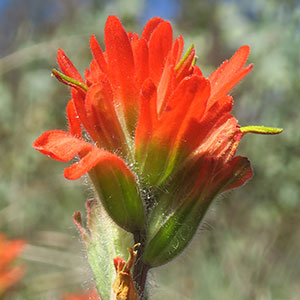Castilleja brevilobata
Castilleja pallescens
short-lobed paintbrush
dwarf pale paintbrush, pale Indian paintbrush, pale paintbrush
solitary or few, erect or ascending, unbranched, sometimes branched, hairs spreading, short, medium, and long, soft, short and medium ones short stipitate-glandular.
few to many, erect to ascending, decumbent at base, unbranched, sometimes branched, hairs moderately to very dense, retrorsely curved to appressed, short, ± stiff, eglandular.
green or ± yellow, lanceolate, elliptic, or oblong to narrowly ovate, 1–2(–2.5) cm, not fleshy, margins plane or wavy, involute, (0–)3–5(–7)-lobed, apex rounded to acute;
lobes ascending to erect, linear to lanceolate, apex rounded to acute.
purple-tinged or deep purple, sometimes green, linear to narrowly lanceolate, 1–4(–5) cm, not fleshy, margins plane, sometimes ± wavy, ± involute, (0–)3–5(–7)-lobed, apex acute;
lobes spreading or ascending-spreading, linear, apex acute.
3–20 × 2–3.5 cm;
bracts proximally greenish to dull brown, distally red, orange-red, or scarlet, sometimes orange or yellow, broadly lanceolate or oblong, (0–)3–5-lobed;
lobes ascending, broadly to narrowly lanceolate, short, arising above mid length, apex acute, obtuse, or rounded.
(1.5–)4–8(–12) × 1.5–5.5 cm;
bracts pale green to yellow-green or reddish purple throughout, or proximally pale green to yellow-green, distally white to cream or pale yellowish, sometimes pink to reddish purple, lanceolate to linear-lanceolate, elliptic, or ovate, 3–5(–9)-lobed;
lobes spreading to ascending, linear, long, arising along distal 2/3, apex acute to obtuse.
straight, 15–24(–26) mm;
tube 12–16 mm;
beak exserted, abaxial lip equal to calyx;
beak adaxially green or ± yellow-green, 7–10 mm, puberulent, stipitate-glandular;
abaxial lip deep green, reduced, rounded, 1–2 mm, 10–25% as long as beak;
teeth incurved to erect, light green, 0.5–1 mm.
straight, 13–23(–27) mm;
tube 10–20 mm; subequal to calyx or beak slightly exserted;
beak adaxially whitish or buff, rarely pink to pink-purple, 3.5–8 mm;
abaxial lip proximally green, white, purple, or purplish brown, distally white, yellow, green, pink, or reddish, prominent, pouched, pouches pleated, longer than deep, gradually expanded, 2.5–8 mm, 70–100% as long as beak, puberulent;
teeth erect to spreading, pink, cream, or white, sometimes with a yellow spot proximally, 1.5–3.5 mm.
green or whitish with green veins, lobes colored as bract lobes or paler, 14–30 mm;
abaxial and adaxial clefts 5.5–8.5 mm, 30–40% of calyx length, deeper than laterals, lateral 1.5–4 mm, 20–25% of calyx length;
lobes oblong to narrowly triangular, apex obtuse to rounded.
colored as bracts, sometimes distally purple with age, 11–25(–27) mm;
abaxial and adaxial clefts 7–13.6 mm, 40–50% of calyx length, deeper than laterals, lateral 0.5–4.3(–6) mm, (0–)5–25% of calyx length;
lobes lanceolate to triangular, apex usually triangular or acute, rarely ± obtuse.
= 24.
= 24, 48.
Castilleja brevilobata
Castilleja pallescens
Castilleja brevilobata is endemic to dry serpentine openings in the Siskiyou Mountains of southwestern Oregon and adjacent California. Although sometimes treated as part of C. applegatei or C. hispida, its morphology does not suggest a close connection with either. This species occasionally hybridizes with C. pruinosa in Del Norte County, California.
(Discussion copyrighted by Flora of North America; reprinted with permission.)
Varieties 2 (2 in the flora).
Castilleja pallescens occurs from valleys to alpine ridges and summits throughout its range, usually in sagebrush communities, but at higher elevations it is also found on dry sites associated with other plant species. The alpine plants are greatly reduced in stature.
(Discussion copyrighted by Flora of North America; reprinted with permission.)
1. Bracts not rigid, veins inconspicuous, usually same color as surfaces; herbs (0.5–)1–3 dm; ne Idaho, sw Montana, nw Wyoming. | var. pallescens |
1. Bracts rigid, veins prominent, pale and contrasting with color of surfaces; herbs 0.4–1.2(–1.7) dm; s, se Idaho, ne Nevada, Oregon. | var. inverta |


